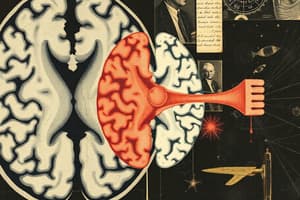Podcast
Questions and Answers
What characterizes an embolic stroke?
What characterizes an embolic stroke?
- It causes bleeding within brain tissue.
- A clot forms elsewhere and travels to the brain. (correct)
- A blockage occurs within the brain's arteries.
- It involves rupturing of a blood vessel.
Which of the following is NOT a risk factor attributed to stroke?
Which of the following is NOT a risk factor attributed to stroke?
- Family history of stroke
- High blood pressure
- Underactive thyroid gland (correct)
- Obesity
What neurological deficit is most commonly associated with a left brain stroke?
What neurological deficit is most commonly associated with a left brain stroke?
- Dysphagia
- Emotional instability
- Impaired spatial perception
- Aphasia (correct)
What is the primary cause of ischemic stroke?
What is the primary cause of ischemic stroke?
Which of the following is a major risk factor for both ischemic and hemorrhagic strokes?
Which of the following is a major risk factor for both ischemic and hemorrhagic strokes?
Which statement about Transient Ischemic Attack (TIA) is accurate?
Which statement about Transient Ischemic Attack (TIA) is accurate?
Which imaging technique is typically used first to differentiate between ischemic and hemorrhagic strokes?
Which imaging technique is typically used first to differentiate between ischemic and hemorrhagic strokes?
Which of the following is a symptom of a stroke?
Which of the following is a symptom of a stroke?
Which lifestyle modification is NOT recommended for preventing stroke risk?
Which lifestyle modification is NOT recommended for preventing stroke risk?
What is the primary goal of thrombolysis in stroke management?
What is the primary goal of thrombolysis in stroke management?
Flashcards
Ischemic Stroke
Ischemic Stroke
Most common type of stroke (85%), caused by a blockage in a brain artery.
Hemorrhagic Stroke
Hemorrhagic Stroke
Stroke caused by bleeding in or around the brain (15% of cases).
Intracerebral Hemorrhage
Intracerebral Hemorrhage
Bleeding within the brain tissue.
Transient Ischemic Attack (TIA)
Transient Ischemic Attack (TIA)
Signup and view all the flashcards
Cerebral Autoregulation
Cerebral Autoregulation
Signup and view all the flashcards
Stroke Manifestations
Stroke Manifestations
Signup and view all the flashcards
Left Brain Stroke
Left Brain Stroke
Signup and view all the flashcards
Ischemic Stroke Risk Factors
Ischemic Stroke Risk Factors
Signup and view all the flashcards
Stroke Diagnostic Test
Stroke Diagnostic Test
Signup and view all the flashcards
Stroke ABCs
Stroke ABCs
Signup and view all the flashcards
Study Notes
Types of Stroke: Pathophysiology and Clinical Manifestations
-
Ischemic Stroke: A blood clot or blockage reduces blood flow to the brain, causing cell death due to oxygen deprivation. Clinical presentations include sudden weakness, facial droop, slurred speech, vision problems, dizziness, and difficulty walking.
-
Hemorrhagic Stroke: A blood vessel in the brain ruptures, leading to bleeding and increased pressure on brain tissue. Clinical manifestations include severe headache, nausea, vomiting, loss of consciousness, seizures, weakness, or numbness.
-
Transient Ischemic Attack (TIA): A temporary blockage of blood flow to the brain. Symptoms are similar to a stroke but resolve within 24 hours, with no permanent damage.
Comprehensive Nursing History and Focused Physical Assessment for Stroke Patients
-
Primary Survey (ABCDE):
- A (Airway): Ensuring open airway patency.
- B (Breathing): Assessing respiratory rate, effort, and oxygen saturation.
- C (Circulation): Evaluating blood pressure, heart rate, and peripheral perfusion.
- D (Disability): Assessing neurological status using the Glasgow Coma Scale, pupil response, and limb strength.
- E (Exposure): Exposing the patient to check for injuries and skin changes.
-
History Taking (AMPLE):
- Allergies
- Medications
- Past medical history
- Last meal
- Events leading to condition
-
Focused Physical Assessment: Assessing cranial nerves, speech, facial symmetry, limb movement, coordination, and sensation.
Diagnostic Tests and Investigations for Stroke
-
CT Scan (Non-contrast): Initial test to differentiate between ischaemic and hemorrhagic stroke.
-
MRI: Detailed brain tissue imaging, especially useful in early stroke.
-
Carotid Ultrasound: Assesses blood flow and blockages in the carotid arteries.
-
ECG: Identifies possible cardiac issues, like atrial fibrillation, that may cause emboli.
Recognising Clinical Cues for Deterioration in Stroke Patients
-
Sudden decline in consciousness or responsiveness
-
Increasing weakness or paralysis
-
Worsening speech or communication difficulties
-
Severe headache, nausea, or vomiting
-
Changes in pupil size or reactivity
-
Altered respiratory patterns or signs of aspiration
-
Seizures or signs of increased intracranial pressure
Developing a Therapeutic Plan of Care for Stroke Patients
-
Assessment Findings: Review diagnostic results, neurological assessments, and vital signs.
-
Clinical Reasoning Cycle: Consider patient situation, collect cues and information, process information, identify problems, establish goals, take action, and evaluate outcomes.
-
Goal: Reduce brain damage, restore circulation, prevent complications.
-
Team Roles: Neurologist, nurse, physiotherapist, speech therapist.
Collaborative Management Strategies in Acute Care Setting
-
Early Interventions (Ischaemic Stroke): Administer thrombolytics within 3-4.5 hours of symptom onset.
-
Early Interventions (Hemorrhagic Stroke): Manage blood pressure, and consider potential surgery.
Risk Factors for Stroke
-
Non-modifiable risk factors: Age, family history, gender.
-
Modifiable risk factors: High blood pressure, smoking, heart disease, high cholesterol, lack of exercise, poor diet, sleep apnea.
Diagnostic Investigations
- Key Imaging: CT scan (non-contrast) to differentiate ischemic from hemorrhagic stroke; MRI to assess brain tissue damage; Carotid ultrasound for assessing blood vessels.
Assessment, Diagnosis, and Interventions (Nursing and Medical)
-
Airway, Breathing, Circulation: Monitor vital signs, and manage breathing and circulation difficulties.
-
Neurological Monitoring: Frequent assessment to evaluate the progression or improvement of neurological status.
-
Blood Pressure Control: Maintain within safe limits for appropriate management of ischemic and hemorrhagic stroke.
-
Thrombolytics (for ischemic strokes): Administered if indicated, with close monitoring for bleeding.
-
Rehabilitation and Long-term Care: Physical and occupational therapy for improving mobility and self-care.
-
Psychosocial Support: Addressing emotional impacts and promoting coping strategies.
Studying That Suits You
Use AI to generate personalized quizzes and flashcards to suit your learning preferences.




